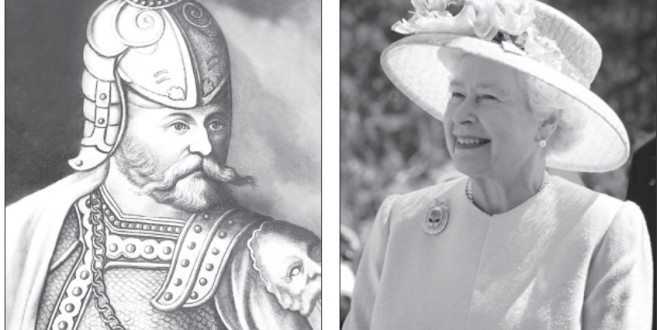by Prof. Alfredas Bumblauskas

The first answer is, they are all connected with the great Shakespeare, The second answer is, I reveal the secret: they all are connected by their links with Lithuania.
GREAT BRITAIN–LITHUANIA: DIFFERENT HISTORICAL CONTEXTS?
When I was offered to make a speech on the occasion of the arrival of the Queen of Great Britain to Lithuania, I was at a loss. We are located at different ends of Europe, the curves of our histories differ significantly – Great Britain belongs to the nucleus of European and Western civilization, and Lithuania is a periphery. England has kept alive its national and cultural traditions since the Middle Ages, whereas Lithuania has suffered many heavy losses: at the end of the 18th century it lost its state; under the conditions of Russian occupation it lost its aristocracy in the 19th century, which joined the Polish nation. In the middle of the 20th century, after a short period of independence, totalitarian regimes killed or drew out of Lithuania not only the intelligentsia but also one fourth of society.
Even more confusing is the question of the British aristocracy in Lithuania and the Lithuanian aristocracy in Britain. Great Britain really has its aristocracy, however, what does Lithuania have to do with it? Modern Lithuania was not too eager to integrate into the Polonized aristocracy of the old Lithuania, therefore it has not looked for its aristocratic traditions up to recently. So, let us proceed to a search for the Lithuanian aristocracy and British-Lithuanian relations in the Middle Ages – we might then accidentally find the connections between the realms of England and Lithuania.
THE GRAND DUCHY OF LITHUANIA AS A SANCTUARY
We shall now talk about the fact that in the middle of the 19th century the town of Klaipėda was called London Minor.
Merchants from Britain lived in the Baltic region since the 15th century. It was the reason why Lithuanian rulers and queens of England corresponded about them.
The influence of the local English colony was so great that Russian merchants, who wished to establish trade relations in London, sought to live in Klaipėda for some time to learn English manners and lifestyle. Nevertheless, Klaipėda was part of Prussia rather than of the Grand Duchy of Lithuania. In the 17th century English merchants were settling in Šventoji, the port of the Grand Duchy on the Baltic Sea. Archaeologists have determined this from discovered equipment of their former factories bearing the “Tudor Rose.”
While at the same time the Lithuanian town of Kėdainiai became the residence of Scottish merchants. They built the largest Evangelical Reformed Church in Lithuania there, worked as teachers at the high school that was opened at it, and in this way they integrated into local life so closely that by the end of the 17th century they taught Lithuanians the Lithuanian language, and the Scottish surname Ramsey became the Lithuanian Ramza. One of those teachers, the Rector of Kėdainiai High School, Thomas Ramsey, translated the New Testament into the Lithuanian language. Another translator from Kėdainiai, the alumnus of Oxford University, Boguslavas Čilinskis, was doing similar work in London and the Reformist Bible translated by him was started to be published in London.
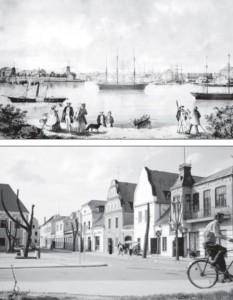
The Scottish merchants were settling in Kėdainiai not as in an ordinary town but as in the “Promised Land” they were looking for, called Antilia. It was natural, Lithuania with its religious pluralism (there were 10 religious confessions), overtook all the countries of Europe in the 16th-17th centuries. This phenomena determined the fact that Lithuania became a sanctuary for the emigrants of different confessions from the West. Depending on the religious situation in Britain, Lithuania served as a sanctuary for both the Protestants and Catholics, the English and the Scots.
In Lithuania Englishmen found people that are described, and I quote in Old English: “an frende unto the English nation.”
King Sigismund Augustus patronized Catherine Duchess of Suffolk (relative of Henry III) and her husband Richard Bertie who had fled persecutions by Queen Mary Tudor. In 1557 they were given a residence in Kražiai in Žemaitija where they spent several years, and according to one of the English chroniclers of that time, I quote, “continued both in great quietness and honor, till the death of Queen Mary.”
After the religious situation in England changed, Lithuania became a sanctuary for the Catholics too. It was the British who were among the first wave of professors who came to work at Vilnius University founded by the Jesuits in 1579. There were some British students at the University too. It seems that it was in Lithuania, as far back as in the times of Shakespeare, that they created the first English verses.
The case of the first professor of mathematics of Vilnius University, James Bosgrave, became especially renowned. While at the university, he carried out geographical measurements of the territory of the Grand Duchy of Lithuania, which formed the basis for the first accurate and most famous map of Lithuania. In 1580 James Bosgrave returned to his Motherland and was arrested as a Catholic. The ruler of Lithuania King Stephen Bathory wrote letters to Queen Elizabeth I concerning James Bosgrave and stating that both Vilnius University and science suffered a great loss without such an eminent professor and wondered why such a pious person was arrested because of his faith. Bathory assured Elizabeth that all her subjects in Poland and Lithuania enjoyed freedom irrespective of their faith and expressed hope that Catholics would be tolerated in England. This had an effect – James Bosgrave and some other Catholics who had been arrested were saved from execution and set free.
THE GRAND DUCHY OF LITHUANIA– BRITAIN IN THE 16TH–17TH CENTURIES: BALANCE OF IDEAS AND PRESTIGE?
In the 15th century Lithuania still was learning from Europe. That’s why it is hard to ascertain one fact. The first printer of London in 1480 was John Lettou. English historians guess that this man was Lithuanian, and write his name as John of Lithuania. It is hardly likely, because such guess is based only upon the sound of the surname.
But in the 16th century it was clear from Stephen Bathory’s position that Lithuania did no longer feel like a pupil, that it had something to say to Britain. This fact was testified even clearer by the position taken by some prominent intellectuals of Lithuania. Simon Budny, the most prominent representative of Lithuanian radical reformation-anti-trinitarianism, who denied the dogma of the Holy Trinity, had ambitions to spread his ideas in the court of Queen Elizabeth of England. According to the Bodleian Library Catalogue of 1620, this library had several books by Andreas Volanus, the most renowned theologian of Lithuanian Calvinists. Works of logic, rhetoric and poetry by the Catholics, professors of Vilnius Jesuit University spread to England as well. Martynas Smigleckis’ book Logica selectis disputationibus et questionibus illustrata was reprinted in Oxford as many as three times in the 17th century. It is often mentioned that even the English novelist Daniel Defoe was being examined according to Smigleckis’ logic. Poetry of Motiejus Kazimieras Sarbievius spread in England even wider. His Lyricorum Libri Tres was not only reprinted in England but also translated into the English language. Kazimieras Semenavičius’ Magna Ars Artileriae published in London in 1729 under the title The Great Art Of Artillery was the most outstanding achievement of the Grand Duchy of Lithuania, as well as an ideological forerunner of modern astronautics. This work demonstrated the level of the military thought, and the Lithuanian victory at Kircholm against the Swedes in 1605 testified to the level of military skills. The coat of arms of the military leader Jonas Karolis Katkevičius can be still seen at the Library of the British Museum in London. The king of England James I congratulated the ruler of Lithuania Sigismund III Vasa on the victory. At the same time, panegyric verses were written in Lithuania to the English on the occasion of their victory against the Spanish Armada.
Various wedding plans of the Polish-Lithuanian rulers demonstrated their ambitions or the concept of prestige of an equal value. Vladislovas IV Vasa entertained thoughts of marrying King James I’s daughter Elizabeth, however, the Pope prevented this marriage by prohibiting him to marry a Protestant. Somewhat earlier, Sigismund Augustus had plans to marry the English princesses Mary Tudor or Elizabeth, the future queens. However, he married Barbara Radvila (Radziwill) through the influence of her powerful family, and besides, love determined the fact that to have a bride from his own country was more important than to have prestigious brides from England.
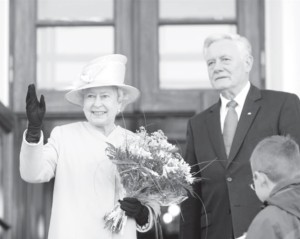
THE KING OF ENGLAND IN LITHUANIA, A LITHUANAN – THE QUEEN OF ENGLAND
Thus far we have spoken about the connections between the realms of Great Britain and Lithuania only in terms of greetings, requests and intentions conveyed through envoys by way of letters. The English were already interested in the political and religious situation of Lithuania during the rule of Vytautas the Great. At the beginning of the 15th century Vytautas was visited by envoys of the King of England Henry V – John Norton and Ghillebert de Lannoy, who visited him twice.
However, it turns out that not only Queen Elizabeth II would visit Lithuania. In 1390, Henry IV was in Lithuania accompanied by a 300- strong contingent of English knights. True, he marched with a weapon in his hand and still as Henry Bolingbroke, Duke of Derby. In this way he helped the Teutonic Knights – despite the fact that Lithuania had been Catholic for three years – quell Europe’s “last pagans.” The most interesting thing is that Vytautas the Great, who was still fighting with his cousin Jogaila for the throne, marched together with the Teutonic knights and the English knights. Two English knights were taken prisoner concerning whom King Richard II wrote to King Jogaila. It is generally agreed that Henry Bolingbroke’s campaign in Lithuania and his personality inspired some of the motives in Geoffrey Chaucer’s The Canterbury Tales.
Henry Bolingbroke replaced Richard II as king and became Henry IV. We all know these facts by reading Shakespeare. However, perhaps few of us know that Richard II’s first wife Anna of Bohemia was a descendant of Gediminas, the progenitor of the rulers of Lithuania, the Gediminids. Genealogists usually see the male lines, but let us look at the female lines. Gediminas – his daughter Aldona (wife of King of Poland Casimir III the Great) – her daughter, Elizabeth von Piasten (wife of Duke Boguslav of Pomerania) – Elizabeth of Pomerania (wife of Charles IV, Holy Roman Emperor) – Anne of Bohemia (wife of Richard II). Hence, though fragmentary, one can discern connections between the realms of England and Lithuania. However, the most interesting thing is that the English historian, currently working in Lithuania, Stephen Rowell, has recently put forward the idea that there were Gediminids among the ancestors of Queen Elizabeth II!.
GREAT BRITAIN AND THE FATE OF THE ARISTOCRACY OF LITHUANIA.
The Gediminid line usually ends in 1572 with the death of Sigismund Augustus. Still, there were other members of the Gediminids who did not succeed to the throne, for example, the Sanguška family or the Čartoriškis family, who played an important role in the history of Lithuania for as long as 1795. The same can be said about the dukes Giedraitis and the Radvila family, which acquired the titles of Princes of the Holy Roman Empire. Nevertheless, the destruction of the state, the Polonization processes, and finally the epoch of Communism, determined that they have become part of the Polish émigré community. However Michael Giedroyc (Giedraitis) from Oxford does not only recall Lithuania but also investigates its history. There are many more members of the Giedraitis, Čartoriškis and Radvila families residing in Britain and elsewhere. Let us hope they remember their Lithuanian origin and help us remember our history. Discovery of monarchic and aristocratic traditions in Lithuania might be one of those nuances which enable to view Great Britain and Lithuania not only as countries of different historic fates.
THE THEATRE AS THE ABODE OF ARISTOCRACY OF SPIRIT?
Let us go back to Shakespeare. In his book The Empty Space, the English producer Peter Brooke sees John Gielgud as one of the most outstanding figures of the world theatre distinguished for, and I quote, “the inborn aristocracy of spirit.” However, the most interesting thing is that John Gielgud came from the Lithuanian aristocracy. His relative Antanas Gelgaudas was the leader of the 1831 uprising against Russia in Lithuania. Peter Brooke once stated that the greatest appreciation of the actor is not the ovations given after the play but a moment-lasting silence. This is catharsis. According to the press, such was the response of the audience at some theatre in England after the opening night of Shakespeare’s Macbeth staged by the most famous contemporary Lithuanian theatre director, Eimuntas Nekro- šius. Hence, the theatre, Shakespeare, John Gielgud, and their heroes Richard II and Henry IV really connect England and Lithuania. Perhaps this is the link of aristocratic spirit?
POST SCRIPTUM
While preparing this speech, I tried to make some analysis about Elizabeth II’s genealogy. It was based upon the English historian, Stephen Rowell’s idea that there were Gediminids among the ancestors of Elizabeth II. And here, I would like to present you a little sensation (at least it is such for me): Gediminas is Elizabeth II’s ancestor of the 20th generation.
ENGLISH NOBLEMEN IN OR NEAR LITHUANIA
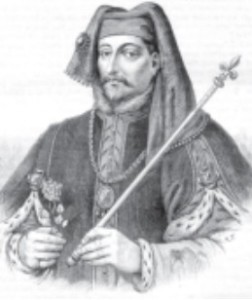
Henry Bolingbroke (1367-1413), Earl of Derby and future King of England as Henry IV (he also claimed the titles of King of France and Lord of Ireland), joined a Crusade in 1390 to convert the Lithuanian “infidels.” The fact that Vytautas the Great and his cousin Jogaila were already Christians, and that three years earlier the majority of their subjects were baptized, and that in 1389 Pope Urban VI had officially recognized Lithuania as a Roman Catholic state, didn’t make that much difference to the Crusaders.
Henry Bolingbroke spent a full year in supporting the unsuccessful siege of Vilnius (capital of the Grand Duchy of Lithuania) by the Teutonic Knights with his 300 fellow knights. He was 23 at the time. Although they succeeded in destroying the so-called “Crooked Castle” (Kreivoji pilis), one of Vilnius’ three castles, they failed to subjugate the city. During this campaign Henry also bought captured Lithuanian princes and then apparently took them back to England.
Henry’s second unsuccessful expedition to Lithuania in 1392 illustrates the financial benefits to the Teutonic Order of these guest Crusaders. His small army consisted of about 100 men, including longbow archers and six minstrels, at a total cost of £4,360 to the House of Lancaster’s purse. Much of this sum benefited the local economy of the Order’s lands through the purchase of silverware and the hiring of boats and equipment. Despite the efforts of Henry and his English Crusaders, two years of attacks on Vilnius proved fruitless. So he decided to go to the Holy Land instead, where he gained a reputation of a seasoned warrior and courtier.
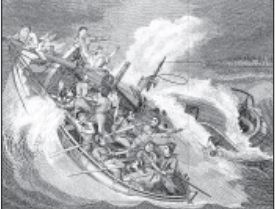
Philip Lord Viscount Royston (1784-1808), eldest son of the Earl of Hardwicke was a British nobleman who travelled through Russia in the early part of the 19th century, braving near-fatal conditions and the death of several servants, only to be killed by a squall off the coast of Klaipėda.
Lord Royston embarked from England on July 1, 1806, and after visiting Denmark and Sweden he arrived at Saint Petersburg from where he travelled to Moscow. From there he went on a two-year journey which took him through some of the most distant provinces of the Russian Empire. In the north he travelled as far as the Arctic Circle, and in the east to the borders of Asia. Exhausted and in ill health, he decided to return to England by way of Moscow and Saint Petersburg.
After arriving in Moscow he found out that war had broken out between Russia and England. So instead of embarking from Saint Petersburg, he decided to go to Libau in the Duchy of Courland (present-day Latvia) from where he would sail for Sweden on his way back to England. He embarked on the vessel “Agatha” on April 2, 1808. On the fifth day of sailing the ship was caught in a terrible storm. Water filled the ship’s bottom and it was in danger of sinking, so it was decided to go to the nearest port, which was Klaipėda. But a mile and a half from the port and in sight of the harbor, the ship ran aground on a sand bar. The storm was so intense that some passengers and crew were washed overboard by the waves and drowned. Some rescue boats were launched from Klaipėda and brought some people ashore, but the one that carried Lord Royston and several others capsized and they were all washed away to their deaths.
 DRAUGAS NEWS Lithuanian World Wide News in English
DRAUGAS NEWS Lithuanian World Wide News in English
